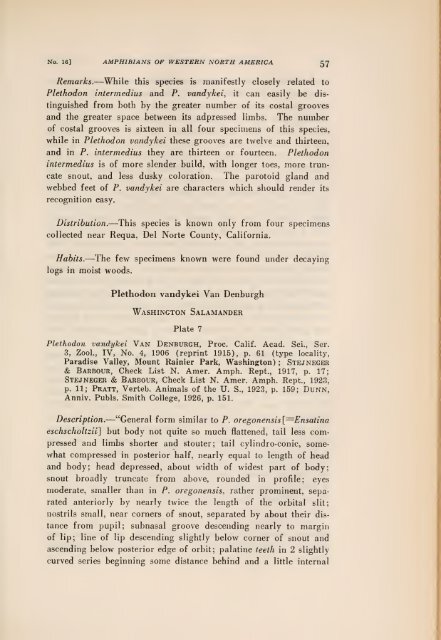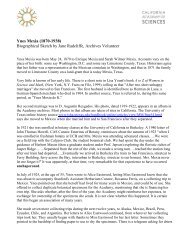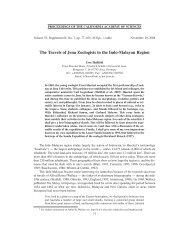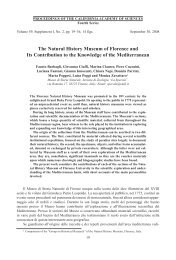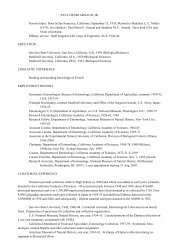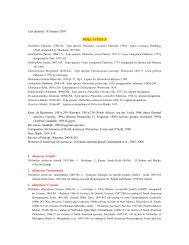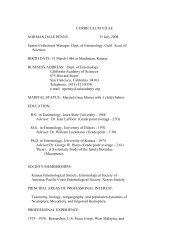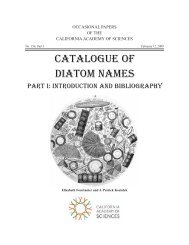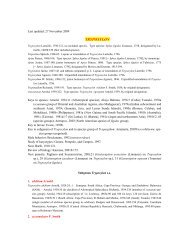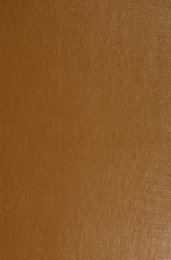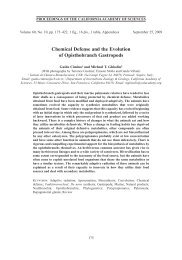PDF (9.91 MB) - Academy Research - California Academy of Sciences
PDF (9.91 MB) - Academy Research - California Academy of Sciences
PDF (9.91 MB) - Academy Research - California Academy of Sciences
You also want an ePaper? Increase the reach of your titles
YUMPU automatically turns print PDFs into web optimized ePapers that Google loves.
No. 16] AMPHIBIANS OF WESTERN NORTH AMERICA 57<br />
Remarks.— While this species is manifestly closely<br />
related to<br />
Plethodon intermedius and P. vandykei, it can easily be distinguished<br />
from both by the greater number <strong>of</strong> its costal grooves<br />
and the greater space between its adpressed limbs. The number<br />
<strong>of</strong> costal grooves is sixteen in all four specimens <strong>of</strong> this species,<br />
while in Plethodon vandykei these grooves are twelve and thirteen,<br />
and in P. intermedius they are thirteen or fourteen. Plethodon<br />
intermedius is <strong>of</strong> more slender build, with longer toes, more truncate<br />
snout, and less dusky coloration. The parotoid gland and<br />
webbed feet <strong>of</strong> P. vandykei are characters which should render its<br />
recognition easy.<br />
Distribution.— This species is known only from four specimens<br />
collected near Requa, Del Norte County, <strong>California</strong>.<br />
Habits.— The few specimens known were found<br />
logs in moist woods.<br />
under decaying<br />
Plethodon vandykei Van Denburgh<br />
Washington Salamander<br />
Plate 7<br />
Plethodon vandykei Van Denburgh, Proc. Calif. Acad. Sci., Ser.<br />
3, Zool., IV, No. 4, 1906 (reprint 1915), p. 61 (type locality,<br />
Paradise Valley, Mount Rainier Park, Washington) ;<br />
Stejneger<br />
& Barbour, Check List N. Amer. Amph. Rept., 1917, p. 17;<br />
Stejneger & Barbour, Check List N. Amer. Amph. Rept, 1923,<br />
p. 11; Pratt, Verteb. Animals <strong>of</strong> the U. S., 1923, p. 159; Dunn,<br />
Anniv. Pubis. Smith College, 1926, p. 151.<br />
Description. — "General form similar to P. oregonensis [=Ensatina<br />
eschscholtzii] but body not quite so much flattened, tail less compressed<br />
and limbs shorter and stouter; tail cylindro-conic, somewhat<br />
compressed in posterior half, nearly equal to length <strong>of</strong> head<br />
and body; head depressed, about width <strong>of</strong> widest part <strong>of</strong> body;<br />
snout broadly truncate from above, rounded in pr<strong>of</strong>ile; eyes<br />
moderate, smaller than in P. oregonensis, rather prominent, separated<br />
anteriorly by nearly twice the length <strong>of</strong> the orbital slit;<br />
nostrils small, near corners <strong>of</strong> snout, separated by about their distance<br />
from pupil; subnasal groove descending nearly to margin<br />
<strong>of</strong> lip; line <strong>of</strong> lip descending slightly below corner <strong>of</strong> snout and<br />
ascending below posterior edge <strong>of</strong> orbit; palatine teeth in 2 slightly<br />
curved series beginning some distance behind and a little internal


